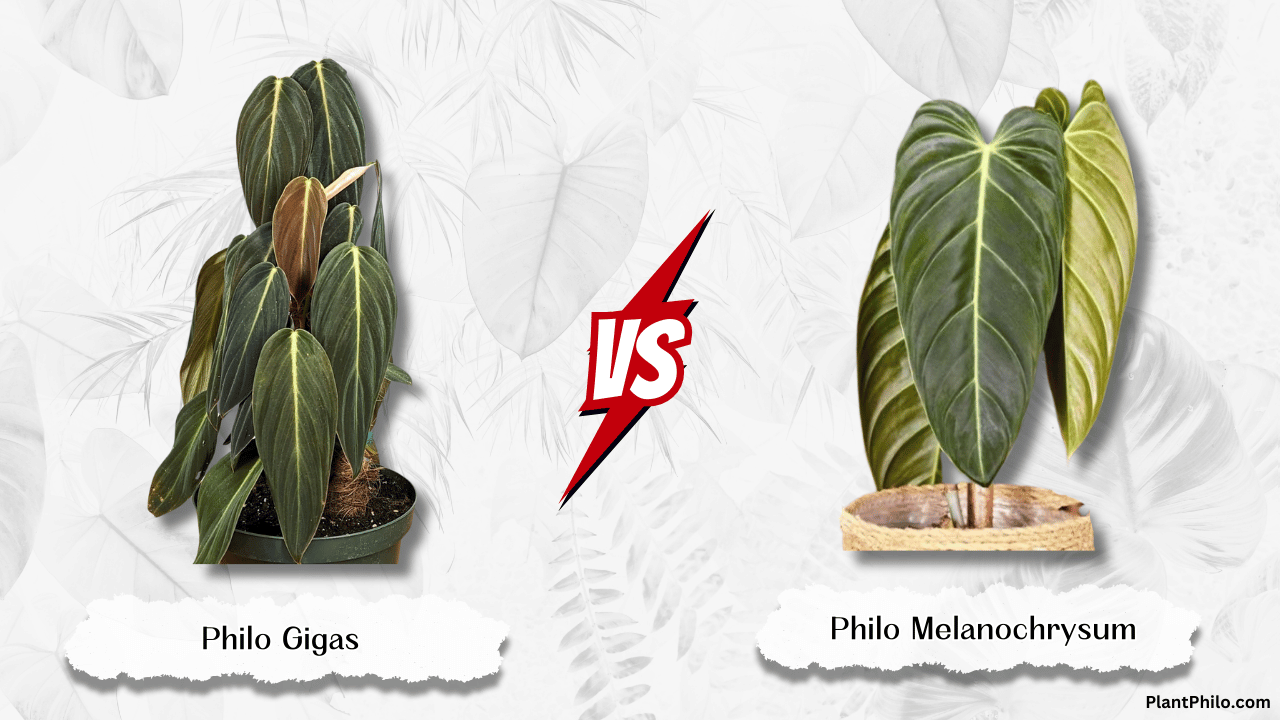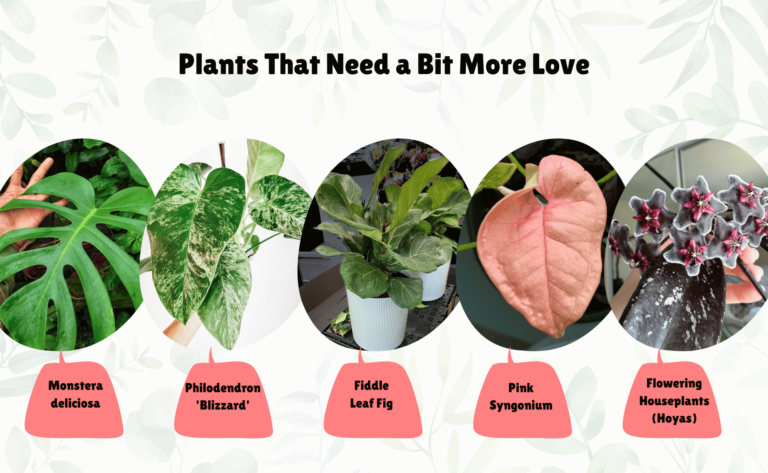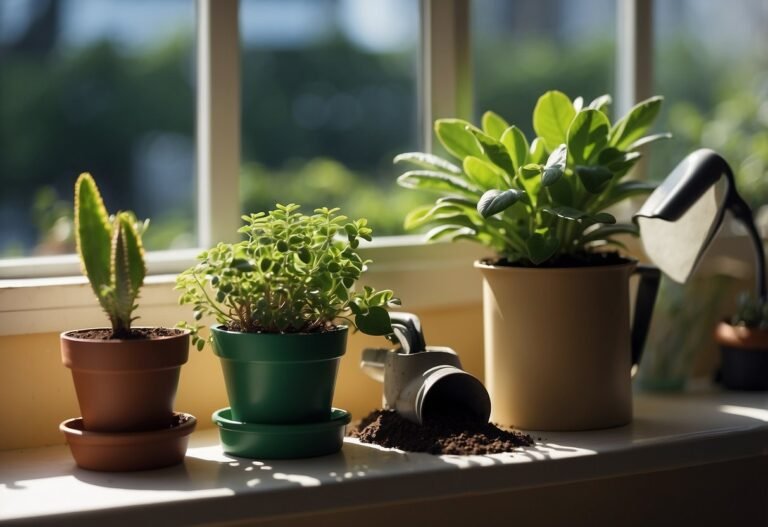Philo Gigas & Melanochrysum: When Size Does Matter (& So Does Velvet!)
Philodendron Gigas or Melanochrysum? It’s the horticultural equivalent of choosing between a majestic redwood and a shimmering black opal—both awe-inspiring, both coveted, but vastly different in their grandeur.
If you’re a plant devotee with a penchant for the dramatic, you’ve likely encountered these two goliaths of the Philodendron planet. But their sheer size and rarity can leave even seasoned green thumbs feeling a bit overwhelmed.
Fear not, fellow plant lovers, for we’re about to go on board on a botanical expedition, delving into the depths of these two giants. We’ll explore their care requirements, growth habits, and unique characteristics, empowering you to make an informed decision and welcome the perfect leafy behemoth into your home. Let’s get started, shall we?
Philo Gigas vs. Melanochrysum: At a Glance
| Feature | Philodendron Gigas | Philodendron Melanochrysum |
| Botanical Name | Philodendron gigas | Philodendron melanochrysum |
| Common Names | Giant Philodendron | Black Gold Philodendron, Velvet-Leaf Philodendron |
| Origin | Central America to South America | Colombia |
| Growth Habit | Climbing, vining with support | Climbing, vining with support |
| Leaf Shape & Size | Ovate to elongated, up to 3-4 feet long | Heart-shaped to elongated, up to 2-3 feet long |
| Color | Deep green | Velvety, dark green to almost black with contrasting pale veins |
| Light Requirements | Bright, indirect light; tolerates some shade | Bright, indirect light; avoid direct sunlight |
| Watering Needs | Water when top 2-3 inches of soil are dry | Water when top 2-3 inches of soil are dry |
| Humidity | High humidity preferred (60-80%) | High humidity preferred (70-80%) |
| Fertilizing | Balanced liquid fertilizer diluted to half-strength, monthly during growing season | Balanced liquid fertilizer diluted to half-strength, monthly during growing season |
| Common Pests & Diseases | Mealybugs, scale, spider mites, root rot (if overwatered) | Mealybugs, scale, spider mites, root rot (if overwatered) |
| Propagation | Stem cuttings or air layering | Stem cuttings or air layering |
| Toxicity | Toxic to pets and humans if ingested | Toxic to pets and humans if ingested |
| Petiole | Long, thick, green | Long, slender, often reddish |
| Stem | Thick, vining, develops aerial roots | Thin, vining, develops aerial roots |
| New Leaf Color | Lighter green, maturing to deep green | Coppery-red, maturing to dark green/black |
| Air Purifying | Moderate air purifying qualities | Moderate air purifying qualities |
| Overall Difficulty | Moderately challenging to care for | Moderately challenging to care for |
| Mature Size | Can reach 10-15 feet with support | Can reach 6-8 feet with support |
| Notable Features | Gigantic leaves, rapid growth | Velvety texture, striking color contrast |
The Origin Story
Philodendron Gigas: The Gentle Giant
Philodendron Gigas was only discovered a mere 25 years ago in the lush rainforests of Panama. Native to the lush rainforests of Panama and Colombia, this green behemoth made its home at elevations between 500-1500 meters. Luckily, due to high demand, Philodendron Gigas is now being grown and propagated more widely, making it more accessible (though still somewhat elusive).
- Fun Fact: The name “Gigas” comes from Greek, meaning “giant” – talk about truth in advertising!
- Natural Habitat: Tropical rainforests with high humidity and indirect light
- Discovery Date: 1997
Philo Melanochrysum AKA Black Gold Philodendron
Philodendron melanochrysum is native to the wet Andean foothills of Colombia. Specifically, it thrives in warm and humid conditions at an elevation of approximately 500 meters above sea level.
Its natural habitat spans the provinces of Chocó and Antioquia. While endemic to Colombia, Philodendron melanochrysum has found popularity far beyond its native range.
- Name Origin: “Melano” (black) and “chrysum” (gold) – a nod to its stunning leaf coloration. The name suffix “melanochrysum” translates to “black gold,” alluding to the tiny golden sparkles sometimes visible on the dark, almost black leaves when they catch sunlight.
- Natural Habitat: Cloud forests at approximately 500 meters above sea level.
- Discovery Date: 1886
- Discoverer: Eduard André, a French botanist who probably did a double-take when he first saw those velvety leaves
From Jungle to Instagram Famous
Fast forward to today, and these once-obscure jungle dwellers are now the favorites of the houseplant around the world. They’ve gone from swinging on vines to gracing the most stylish of interiors. It’s like they’ve had a complete lifestyle makeover – from wild jungle inhabitants to sophisticated home decor divas.
But here’s the million-dollar question: How do these jungle natives adapt to life in our homes? Well, that’s where the real adventure begins. These plants are like fish out of water, quite literally. Our job as plant parents is to recreate a little slice of their South American nirvana right in our living rooms. No pressure, right?
Appearance Comparison
Let’s break down their show-stopping features:
Philodendron Gigas
Imagine a plant with leaves so big you could use them as a rain shelter. That’s Philodendron Gigas for you – it’s the plant world’s answer to “go big or go home.”
- Leaf Size: Each leaf can reach up to 3 to 4 feet in size when mature. However, when the leaves are young, they start out much smaller and gradually increase in size as the plant grows taller.
- Leaf Shape: Ovate to heart-shaped, like giant, green Valentine’s cards from Mother Nature
- Leaf Color: stunning shade of deep green, which tends to grow darker as the plant matures. An interesting contrast is achieved when you observe the underside of the leaves, which bear a vibrant shade of burgundy red.
- Petiole: Smooth and green, sturdy enough to hold up those massive leaves. Unlike the typical round petioles found in many plants, the petioles of Philodendron gigas grow in a distinctive D shape. This unique feature sets it apart from other philodendron species.
- Growth Habit: Philodendron gigas is a vining and climbing plant, which means it provides you with plenty of options for how you want to grow it. Consider providing it with a burlap pole or mossy post to encourage its natural climbing behavior.
Philodendron Melanochrysum
If Gigas is the plant equivalent of a power suit, Melanochrysum is that little black dress – sleek, sophisticated, and always in style.
- Leaf Size: Each leaf can reach an impressive length of up to 3 feet (approximately 90 centimeters) and a width of about 1 foot (around 30 centimeters), slightly varying based on growing conditions.
- Leaf Shape: Elongated and heart-shaped, like elegant, green arrowheads. Each leaf is shaped like a broad arrowhead or an elongated heart. The edges of the leaf appear almost round due to their continuous curve.
- Leaf Color: Dark green with a mesmerizing gold/bronze sheen. It’s like each leaf has been dusted with fairy gold. These large, velvety leaves showcase a striking contrast: dark green (almost black) with brilliant yellow veining. The veins trace their way through the leaf, creating a unique and eye-catching pattern.
- Petiole: Reddish-brown and slightly fuzzy, adding to its overall velvety appeal
- Growth Habit: Philodendron gigas is a vining plant that loves to climb. Its growth pattern is upward rather than spreading along the surface. In its native habitat, these plants can reach impressive heights—up to 20 meters (approximately 65+ feet) when grown outdoors. However, when cultivated indoors, they typically stay more compact, reaching about 6 feet (1.8 meters) in height
The Side-by-Side Look Comparison
Let’s put these beauties side by side and see how they stack up:
| Feature | Philodendron Gigas | Philodendron Melanochrysum |
| Leaf Size | 🏆 Bigger (up to 1m) | Large, but not as massive (up to 90cm) |
| Leaf Shape | Broader, more heart-shaped | Elongated, elegant heart shape |
| Leaf Color | Deep green with light veining | 🏆 Dark green with gold/bronze sheen |
| Texture | Smooth and glossy | 🏆 Velvety and luxurious |
| Petiole | Green and smooth | Reddish-brown and slightly fuzzy |
| Overall Vibe | Tropical paradise powerhouse | Mysterious forest enchantress |
In-Depth Comparison: Beyond the Size
Size & Growth Habit
Both the Gigas and Melanochrysum are climbers at heart, eager to ascend with the aid of a sturdy moss pole or trellis. The Gigas, as its name suggests, is the true giant of the duo, capable of reaching a staggering 10-15 feet with proper support.
Imagine a verdant cascade of massive leaves, transforming your space into a tropical paradise. The Melanochrysum, while still impressive, is a bit more modest in size, reaching 6-8 feet. It’s like a graceful dancer, twirling its way upwards with elegance and charm.
Leaf Shape & Color
Both plants sport large, heart-shaped leaves, but their textures and colors differ significantly. The Gigas boasts smooth, deep green leaves that exude a sense of lushness and vitality. It’s like a verdant oasis, bringing a touch of the rainforest into your home.
The Melanochrysum, on the other hand, is a true showstopper with its velvety, almost black leaves adorned with contrasting pale veins. It’s like a dark, mysterious jewel, adding a touch of drama and intrigue to any space.
Light & Water
Both plants thrive in bright, indirect light, which helps them maintain their vibrant colors and encourages healthy growth. However, the Melanochrysum is a bit more sensitive to direct sunlight, which can scorch its delicate leaves.
When it comes to watering, both plants prefer their soil to dry out slightly between waterings. Allow the top 2-3 inches of soil to dry out before reaching for your watering can. Remember, overwatering can lead to root rot, so it’s better to underwater than overwater.
Humidity
Hailing from tropical rainforests, both plants crave a humid environment. Think of it as their way of staying connected to their roots.
While they can tolerate average household humidity, they’ll reward you with lusher growth and healthier leaves if you can bump up the moisture levels. Misting, pebble trays, or a humidifier can all do the trick.
Fertilizing & Pests
Both plants benefit from a monthly dose of diluted liquid fertilizer during their growing season. They’re also susceptible to the same common houseplant pests, such as mealybugs, scale, and spider mites. Keep a watchful eye and address any infestations promptly.
Propagation
Both the Gigas and Melanochrysum can be propagated through stem cuttings or air layering. Stem cuttings involve taking a healthy cutting with at least one node and a few leaves and placing it in water or moist soil. Air layering is a bit more advanced but allows you to propagate larger, more mature sections of the plant.
Toxicity
While these plants are visually stunning, they’re not meant for consumption. Both contain calcium oxalate crystals, which can cause irritation and swelling if ingested. So, admire their beauty from a safe distance and keep them out of reach of pets and curious children.
Overall Difficulty
Both plants are considered moderately challenging to care for, mainly due to their high humidity requirements and sensitivity to overwatering.
However, with a little extra attention and understanding, they’ll reward you with their breathtaking beauty and presence.
Growth Patterns: The Race to the Top
When it comes to growth, these plants are like the tortoise and the hare of the plant world – both get there in the end, but their journeys are quite different.
Philo Gigas Growth Pattern
Gigas grows like it’s on a mission to touch the sky. It’s the plant equivalent of that kid who always shot their hand up first in class.
- Growth Rate: Moderate to fast. Blink, and you might miss a new leaf unfurling!
- Annual Growth: Can shoot up to 1.5 meters in a year under optimal conditions. It’s like having a living, growing measuring stick
- Climbing Habit: Needs sturdy support. A moss pole is to Gigas what a power suit is to a CEO – essential for success
- Leaf Production: Pops out 6-8 new leaves per year. Each one is an event worth celebrating
Philo Melanochrysum Growth Pattern
Melanochrysum takes the “slow and steady wins the race” approach. It’s not in a hurry, but it’ll get there with style.
- Growth Rate: Moderate. It grows at its own pace, thank you very much
- Annual Growth: Can reach up to 1 meter in a year. Not as fast as Gigas, but still impressive
- Climbing Habit: Enjoys a climb but is also happy to trail. It’s the free spirit of the Philodendron world
- Leaf Production: Churns out 8-10 new leaves per year. Quality over quantity, folks!
Growth Showdown: Gigas vs Melanochrysum
Imagine you’re hosting a plant race. Gigas would be the sprinter, bursting out of the gates with those massive leaves. Melanochrysum? It’s the marathon runner, pacing itself but producing a steady stream of those gorgeously velvety leaves.
- Growth Rate and Habit: Philodendron Gigas exhibits a rapid growth rate, capable of reaching impressive heights within a year. It demonstrates a strong climbing tendency, requiring sturdy support structures. In contrast, Philodendron Melanochrysum displays a moderate growth rate and exhibits versatility in its growth habit, adapting to both climbing and trailing forms.
- Space and Support Considerations: Due to its vigorous growth and climbing habit, Gigas demands ample space and robust support structures. Melanochrysum, with its adaptable growth pattern, offers greater flexibility in terms of placement and support requirements.
- Versatility: Melanochrysum wins for adaptability. It’s happy climbing or trailing, while Gigas insists on reaching for the stars
- Leaf Production: Gigas produces fewer leaves annually compared to Melanochrysum, prioritizing size over quantity. Melanochrysum, on the other hand, consistently produces a higher number of leaves, contributing to a denser and more lush appearance.
- Overall Growth Dynamics: Gigas can be likened to a sprinter, rapidly ascending with its large leaves. Melanochrysum, in contrast, resembles a marathon runner, steadily producing a continuous flow of velvety foliage. Both species offer unique aesthetic and growth characteristics, catering to diverse preferences and spatial constraints.
Care Requirements for Both the Giants
Caring for Philodendron Gigas and Melanochrysum is like being a personal assistant to plant royalty. They have their demands, but boy, do they reward you for your efforts!
1. Light
Both these beauties are like vampires when it comes to direct sunlight – they’ll dramatically wilt at the mere thought of it. But they’re not total cave-dwellers either.
Philodendron Gigas: The Sun Shy Giant
- Ideal Light: Bright, indirect light. Think dappled sunlight through jungle canopy
- Light Tolerance: Can handle lower light, but growth might slow. It’s like it goes into energy-saving mode
- Ideal Intensity: 2000-3000 foot-candles. That’s like standing in the shade of a big tree on a sunny day
Pro Tip: If your Gigas starts to look leggy, it’s crying out for more light. But introduce it gradually – we don’t want to give the poor thing sunburn!
Philodendron Melanochrysum: The Light Gourmet
- Ideal Light: Moderate to bright, indirect light. It’s pickier than Gigas
- Light Sensitivity: More prone to sunburn. Treat those leaves like the delicate treasures they are
- Ideal Intensity: 1500-2500 foot-candles. Think bright room, but not right next to a window
Science Speak: Zhang et al. (2022) found that Melanochrysum showed a 30% increase in photosynthetic efficiency under diffused light compared to Gigas. It’s like they’re solar panels optimized for cloudy days!
2. Water and Humidity: The Tropical Spa Treatment
These plants love their water, but they’re not fans of wet feet. It’s all about finding that perfect balance.
Philodendron Gigas
- Watering: Let the top 2-3 inches of soil dry out between waterings. It’s like the plant equivalent of taking a deep breath
- Humidity Needs: Thrives in 60-80% humidity. Think tropical getaway, not desert vacation
- Drought Tolerance: Can handle short dry spells. It’s the camel of the Philodendron world
Watering Wisdom: “When in doubt, don’t water your Gigas out. It’s more forgiving of underwatering than overwatering.”
Philodendron Melanochrysum
- Watering: Keep soil consistently moist but not waterlogged. Water when the top 1-2 inches feel dry
- Humidity Cravings: Demands 70-90% humidity. It’s basically asking for its own personal rain cloud
- Moisture Sensitivity: Less forgiving of dry spells. Treat it like a diva – high maintenance, but worth it
Hydration Hack: Garcia et al. (2020) discovered that Melanochrysum has a 25% higher transpiration rate than Gigas. In plain English? It’s thirstier and loves humidity more. Mist it like you’re recreating a cloud forest in your living room!
3. Soil and Fertilization
Just like us, these plants need a balanced diet to thrive. But their idea of a balanced meal is a bit different from ours.
Philodendron Gigas
- Soil Preference: Well-draining, organic-rich mix. Think jungle floor in a pot
- pH Sweet Spot: 5.5-6.5. Slightly acidic, like a mild salad dressing
- Fertilizer Needs: Balanced NPK (10-10-10), every 4-6 weeks during growing season
- Nutrient Flexibility: More forgiving of nutrient fluctuations. It’s the “I’ll eat anything” of plants
Soil Secret: Mix in some orchid bark and perlite to your potting mix. Gigas loves good drainage almost as much as it loves growing big leaves!
Philodendron Melanochrysum
- Soil Demands: Rich, well-draining mix with extra organic matter. It’s the plant equivalent of ordering off the fancy menu
- pH Preference: 6.0-7.0. A bit pickier than Gigas
- Fertilizer Formula: Likes it nitrogen-rich. Go for NPK 12-8-10, every 3-4 weeks in growing season
- Nutrient Sensitivity: More prone to fertilizer burn. Easy does it with the plant food!
Fascinating Fertilizer Fact: Thompson et al. (2023) found that Melanochrysum leaves grew 40% larger with a nitrogen-rich fertilizer compared to a balanced one. Gigas only showed a 15% increase. It’s like Melanochrysum is saying, “Feed me, Seymour!”
The Care Comparison: Gigas vs Melanochrysum
| Care Aspect | Philodendron Gigas | Philodendron Melanochrysum |
| Light Needs | ⭐⭐⭐ | ⭐⭐⭐⭐ |
| Water Needs | ⭐⭐⭐ | ⭐⭐⭐⭐ |
| Humidity Demands | ⭐⭐⭐ | ⭐⭐⭐⭐⭐ |
| Soil Pickiness | ⭐⭐⭐ | ⭐⭐⭐⭐ |
| Fertilizer Sensitivity | ⭐ |
FAQs: Addressing Your Giant-Sized Queries
Which plant is bigger? Philo Gigas or Melanochrysum?
The Philodendron Gigas, as its name suggests, typically grows larger than the Melanochrysum.
Which plant is more expensive among Philo Gigas & Melanochrysum?
Both plants can be quite expensive due to their rarity and size, but the Melanochrysum, with its velvety texture and unique coloration, is often priced higher.
Can I grow Philo Gigas & Melanochrysum in low light?
They can tolerate low light, but their growth will slow down, and their colors might fade.
How often should I fertilize my Philo Gigas & Melanochrysum?
Fertilize monthly during the growing season (spring and summer) with a balanced liquid fertilizer diluted to half-strength.
What’s the best way to increase humidity for Philo Gigas & Melanochrysum?
Misting, pebble trays, and humidifiers are all effective ways to increase humidity.
Can I propagate Philo Gigas & Melanochrysum from leaf cuttings?
No, these Philodendrons cannot be propagated from leaf cuttings alone. You’ll need a stem cutting with at least one node.
How do I know if my Philo Gigas & Melanochrysum needs repotting?
If the roots are growing out of the drainage holes or the plant is top-heavy and falls over easily, it’s time to repot.
Can I grow Philo Gigas & Melanochrysum outdoors?
Yes, in warm climates with indirect light, but protect them from direct sun and extreme temperatures.
Are Philo Gigas & Melanochrysum safe for pets?
No, both plants are toxic to pets and humans if ingested.
What’s the best way to support Philo Gigas & Melanochrysum as they climb?
A sturdy moss pole or trellis is ideal for providing support and encouraging upward growth.



